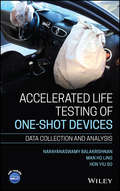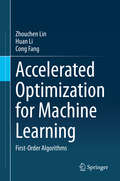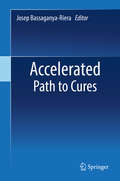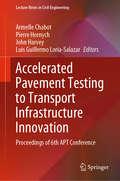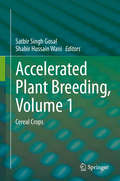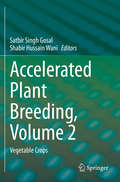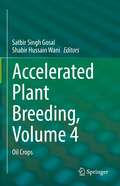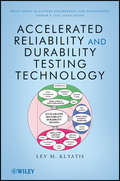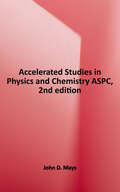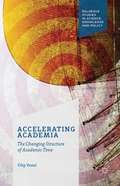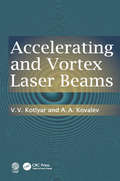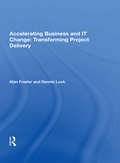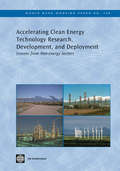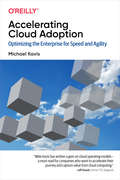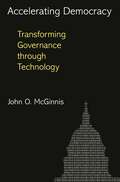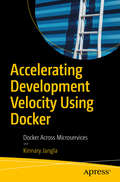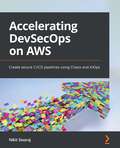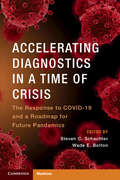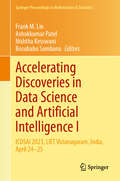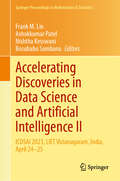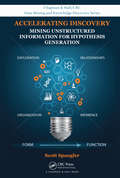- Table View
- List View
Accelerated Life Testing of One-shot Devices: Data Collection and Analysis
by Narayanaswamy Balakrishnan Man Ho Ling Hon Yiu SoProvides authoritative guidance on statistical analysis techniques and inferential methods for one-shot device life-testing Estimating the reliability of one-shot devices—electro-expolsive devices, fire extinguishers, automobile airbags, and other units that perform their function only once—poses unique analytical challenges to conventional approaches. Due to how one-shot devices are censored, their precise failure times cannot be obtained from testing. The condition of a one-shot device can only be recorded at a specific inspection time, resulting in a lack of lifetime data collected in life-tests. Accelerated Life Testing of One-shot Devices: Data Collection and Analysis addresses the fundamental issues of statistical modeling based on data collected from accelerated life-tests of one-shot devices. The authors provide inferential methods and procedures for planning accelerated life-tests, and describe advanced statistical techniques to help reliability practitioners overcome estimation problems in the real world. Topics covered include likelihood inference, competing-risks models, one-shot devices with dependent components, model selection, and more. Enabling readers to apply the techniques to their own lifetime data and arrive at the most accurate inference possible, this practical resource: Provides expert guidance on comprehensive data analysis of one-shot devices under accelerated life-tests Discusses how to design experiments for data collection from efficient accelerated life-tests while conforming to budget constraints Helps readers develops optimal designs for constant-stress and step-stress accelerated life-tests, mainstream life-tests commonly used in reliability practice Includes R code in each chapter for readers to use in their own analyses of one-shot device testing data Features numerous case studies and practical examples throughout Highlights important issues, problems, and future research directions in reliability theory and practice Accelerated Life Testing of One-shot Devices: Data Collection and Analysis is essential reading for graduate students, researchers, and engineers working on accelerated life testing data analysis.
Accelerated Optimization for Machine Learning: First-Order Algorithms
by Zhouchen Lin Huan Li Cong FangThis book on optimization includes forewords by Michael I. Jordan, Zongben Xu and Zhi-Quan Luo. Machine learning relies heavily on optimization to solve problems with its learning models, and first-order optimization algorithms are the mainstream approaches. The acceleration of first-order optimization algorithms is crucial for the efficiency of machine learning. Written by leading experts in the field, this book provides a comprehensive introduction to, and state-of-the-art review of accelerated first-order optimization algorithms for machine learning. It discusses a variety of methods, including deterministic and stochastic algorithms, where the algorithms can be synchronous or asynchronous, for unconstrained and constrained problems, which can be convex or non-convex. Offering a rich blend of ideas, theories and proofs, the book is up-to-date and self-contained. It is an excellent reference resource for users who are seeking faster optimization algorithms, as well as for graduate students and researchers wanting to grasp the frontiers of optimization in machine learning in a short time.
Accelerated Path to Cures
by Josep Bassaganya-RieraAccelerated Path to Cures provides a transformative perspective on the power of combining advanced computational technologies, modeling, bioinformatics and machine learning approaches with nonclinical and clinical experimentation to accelerate drug development. <P><P> This book discusses the application of advanced modeling technologies, from target identification and validation to nonclinical studies in animals to Phase 1-3 human clinical trials and post-approval monitoring, as alternative models of drug development. As a case of successful integration of computational modeling and drug development, we discuss the development of oral small molecule therapeutics for inflammatory bowel disease, from the application of docking studies to screening new chemical entities to the development of next-generation in silico human clinical trials from large-scale clinical data. <P>Additionally, this book illustrates how modeling techniques, machine learning, and informatics can be utilized effectively at each stage of drug development to advance the progress towards predictive, preventive, personalized, precision medicine, and thus provide a successful framework for Path to Cures.
Accelerated Pavement Testing to Transport Infrastructure Innovation: Proceedings of 6th APT Conference (Lecture Notes in Civil Engineering #96)
by Armelle Chabot Pierre Hornych John Harvey Luis Guillermo Loria-SalazarThis volume gathers the latest advances, innovations, and applications in the field of accelerated pavement testing (APT), presented at the 6th International Conference on Accelerated Pavement Testing, in Nantes, France, on September 27-29, 2021. Discussing APT, which involves rapid testing of full-scale pavement constructions for structural deterioration, the book covers topics such as APT facilities, APT of asphalt concrete and sustainable/innovative materials, APT for airfield pavements, testing of maintenance and rehabilitation solutions, testing of smart and multi-functional pavements, data analysis and modeling, monitoring and non-destructive testing, and efficient means of calibrating/developing pavement design methods. Featuring peer-reviewed contributions by leading international researchers and engineers, the book is a timely and highly relevant resource for materials scientists and engineers interested in determining the performance of pavement structures during their service life (10+ years) in a few weeks or months.
Accelerated Plant Breeding, Volume 1: Cereal Crops
by Satbir Singh Gosal Shabir Hussain WaniPlant improvement has shifted its focus from yield, quality and disease resistance to factors that will enhance commerical export, such as early maturity, shelf life and better processing quality. Conventional plant breeding methods aiming at the improvement of a self-pollinating crop, such as wheat, usually take 10-12 years to develop and release of the new variety. During the past 10 years, significant advances have been made and accelerated methods have been developed for precision breeding and early release of crop varieties. This work summarizes concepts dealing with germplasm enhancement and development of improved varieties based on innovative methodologies that include doubled haploidy, marker assisted selection, marker assisted background selection, genetic mapping, genomic selection, high-throughput genotyping, high-throughput phenotyping, mutation breeding, reverse breeding, transgenic breeding, shuttle breeding, speed breeding, low cost high-throughput field phenotyping, etc. It is an important reference with special focus on accelerated development of improved crop varieties.
Accelerated Plant Breeding, Volume 2: Vegetable Crops
by Satbir Singh Gosal Shabir Hussain WaniPlant improvement has shifted its focus from yield, quality and disease resistance to factors that will enhance commercial export, such as early maturity, shelf life and better processing quality. Conventional plant breeding methods aiming at the improvement of a self-pollinating crop, such as wheat, usually take 10-12 years to develop and release of the new variety. During the past 10 years, significant advances have been made and accelerated methods have been developed for precision breeding and early release of crop varieties. This edited volume summarizes concepts dealing with germplasm enhancement and development of improved varieties based on innovative methodologies that include doubled haploidy, marker assisted selection, marker assisted background selection, genetic mapping, genomic selection, high-throughput genotyping, high-throughput phenotyping, mutation breeding, reverse breeding, transgenic breeding, shuttle breeding, speed breeding, low cost high-throughput field phenotyping, etc. It is an important reference with special focus on accelerated development of improved crop varieties.
Accelerated Plant Breeding, Volume 3: Food Legumes
by Shabir Hussain Wani Satbir Singh GosalPlant improvement has shifted its focus from yield, quality and disease resistance to factors that will enhance commercial export, such as early maturity, shelf life and better processing quality. Conventional plant breeding methods aiming at the improvement of a self-pollinating crop, such as wheat, usually take 10-12 years to develop and release of the new variety. During the past 10 years, significant advances have been made and accelerated methods have been developed for precision breeding and early release of crop varieties. This work summarizes concepts dealing with germplasm enhancement and development of improved varieties based on innovative methodologies that include doubled haploidy, marker assisted selection, marker assisted background selection, genetic mapping, genomic selection, high-throughput genotyping, high-throughput phenotyping, mutation breeding, reverse breeding, transgenic breeding, shuttle breeding, speed breeding, low cost high-throughput field phenotyping, etc. It is an important reference with special focus on accelerated development of improved crop varieties.
Accelerated Plant Breeding, Volume 4: Oil Crops
by Shabir Hussain Wani Satbir Singh GosalPlant improvement has shifted its focus from yield, quality and disease resistance to factors that will enhance commercial export, such as early maturity, shelf life and better processing quality. Conventional plant breeding methods aiming at the improvement of a self-pollinating crop usually take 10-12 years to develop and release of the new variety. During the past 10 years, significant advances have been made and accelerated methods have been developed for precision breeding and early release of crop varieties. This book focuses on the accelerated breeding technologies that have been adopted for major oil crops. It summarizes concepts dealing with germplasm enhancement and development of improved varieties based on innovative methodologies that include doubled haploidy, marker assisted selection, marker assisted background selection, genetic mapping, genomic selection, high-throughput genotyping, high-throughput phenotyping, mutation breeding, reverse breeding, transgenic breeding, shuttle breeding, speed breeding, low cost high-throughput field phenotyping, etc. This edited volume is therefore an excellent reference on accelerated development of improved crop varieties.
Accelerated Reliability and Durability Testing Technology
by Lev M. KlyatisLearn how ART and ADT can reduce cost, time, product recalls, and customer complaints This book provides engineers with the techniques and tools they need to use accelerated reliability testing (ART) and accelerated durability testing (ADT) as key factors to accurately predict a product's quality, reliability, durability, and maintainability during a given time, such as service life or warranty period. It covers new ideas and offers a unique approach to accurate simulation and integration of field inputs, safety, and human factors, as well as accelerated product development, as components of interdisciplinary systems engineering. Beginning with a comprehensive introduction to the subject of ART and ADT, the book covers: ART and ADT as components of an interdisciplinary systems of systems approach Methodology of ART and ADT performance Equipment for ART and ADT technology ART and ADT as sources of initial information for accurate quality, reliability, maintainability, and durability prediction and product accelerated development The economical results of the usage of ART and ADT ART and ADT standardization The book covers the newest techniques in the field and provides many case studies that illuminate how the implementation of ART and ADT can solve previously inaccessible problems in the field of engineering, such as reducing product recalls, cost, and time during design, manufacture, and usage. Professionals will find the answers to how one can carry out ART and ADT technology in a practical manner. Accelerated Reliability and Durability Testing Technology is indispensable reading for engineers, researchers in industry, usage, and academia who are involved in the design of experiments, field simulations, maintenance, reliabilty, durabilty, accurate prediction, and product development, and graduate students in related courses.
Accelerated Studies in Physics and Chemistry: A Mastery-Oriented Curriculum
by John D. MaysASPC is an ideal first science course designed for honors-level or accelerated high school students. It can be used for other science classes in high school as well. Teachers may be familiar with IPC courses (integrated physics and chemistry). ASPC is similar but goes deeper into topics so that students get a more enduring introduction. ASPC also moves along a little faster than our other physics offering, Introductory Physics. This accelerated text is for students who love science, are motivated, and are quick on the uptake. Typically, these are students who at least took Algebra I in the 8th grade. They also are organized and know how to study. They also will read the text. As with all Centripetal Press curriculum, ASPC is a "mastery-oriented" text. Mastery learning means different things to different people. To us, it means a series methods and strategies that dramatically improve student retention of content. And Centripetal curriculum has a proven history of accomplishing this. For a full explanation of mastery methods and a philosophy of science education that will transform your school or home learning context, read our forthcoming book from Wonder to Mastery. In short, mastery learning begins with cumulative weekly quizzes (available on the Resource CD for this book). Next, the text is designed to require students to utilize skills and rehearse concepts throughout the school year so that they become a permanent part of the student's knowledge. This is explained further in the introduction. Some of the skills students will learn permanently include unit conversions, scientific notation, significant digits, metric prefixes and more. They will also learn measurement and lab experiment stills through the 6 lab experiments for this text, which can be explored in the book Experiments for Introductory Physics and ASPC. ASPC challenges students to write and speak scientific information accurately and succinctly in their lab reports and chapter exercises. No multiple choice here. As in the real world, exercises and quiz questions consist of either calculation problems or short answer. This course consists of roughly 70% physics and 30% chemistry (see the Table of Contents by clicking the button on this page for more information). As described in our article Sequencing the Secondary Science and Math Curriculum, we recommend the "physics first" approach to high school science because of its advantages over the standard biology-chemistry-physics sequence. Energy, work, Newton's Laws of Motion, substances, electrical circuits, the atomic model, the periodic table, atomic bonding, and other subjects can be closely investigated with Algebra I proficiency.
Accelerating Academia: The Changing Structure Of Academic Time (Palgrave Studies In Science, Knowledge And Policy Ser.)
by Filip VostalFilip Vostal examines the changing nature of academic time, and analyzes the 'will to accelerate' that has emerged as a significant cultural and structural force in knowledge production.
Accelerating and Vortex Laser Beams
by V. Kotlyar A. A. KovalevThis book gives insight into the theoretical backgrounds of optical vortices and their propagation in free space and simple optical systems. The author’s theoretical analysis allows full comprehension of recent results and allows a bridge between the mentioned topics. For example, there is a solution for an accelerating beam propagating along an almost half-circle, obtained from a solution for an asymmetric vortex Bessel mode. And vice versa, there is a solution for an optical vortex with accelerating focusing, obtained from a solution for a two-dimensional accelerating Pearcey beam. The book is intended for graduate and postgraduate students studying optics or wave physics.
Accelerating Business and IT Change: Transforming Project Delivery
by Alan FowlerDespite two decades of investment in project management as many as 80 per cent of business change and IT projects continue to rack up cost overruns and fail to deliver their expected benefits. Business people who must have more certainty in their project investments will find this book refreshing. It contains commonsense but groundbreaking techniques that deal with just this challenge. The authors, far from rejecting current methods, take an imaginative approach to encapsulating established best practices such as PRINCE2™ within a framework of new thinking, innovative techniques and hard-nosed portfolio management. This book shows how project sponsors can radically improve the certainty of getting the benefits that they want and accelerate their projects to get them sooner rather than later (or never). Finance and portfolio managers will find techniques that provide them with the means for drilling down and tracking not only the costs, but also the cash values of project benefits, both tangible and intangible. Business people and project managers will find ideas here that enable them to create and control change in communities of stakeholders; which is the ultimate aim of the organizations that are investing time, resources and money in projects of this kind. Accelerating Business and IT Change is essential reading for anyone seeking to define the nature and value of what they expect from their projects, set realistic implementation schedules and then ensure that all the intended benefits are realized. Important: The CD version of this product requires a Java Run Time environment. If you are planning to use the CD in your office please check with your IT Department to make sure you will be able to use it.
Accelerating Clean Energy Technology Research, Development, and Deployment
by Jonathan Coony Patrick AvatoClimate change is one of the key challenges of this century. At the same time, energy use-the primary source of climate-altering global greenhouse gas emissions-is increasing at unprecedented rates and is vital to the continued economic growth of developing countries. This poses a serious dilemma that can only be reconciled with new and improved clean energy technologies that balance climate change mitigation and increased energy needs in developing countries. Despite a recent increase in investment, public and private research, development, and deployment (RD&D) funding rates are well below historical levels. In addition, significant barriers impede the ability to develop new technologies, such as the uncertain future value of CO2 emissions, intellectual property rights issues, limited incentives to commercialize technologies for developing countries, and challenges with technology transfer. These factors must be overcome to accelerate innovation in the energy sector. To introduce new thinking to address these concerns, this report examines four cases from outside the energy sector where creative approaches to RD&D have successfully overcome similar barriers. The case studies review approaches to innovation by the Consultative Group on International Agricultural Research, Advanced Market Commitments for Vaccines, the Human Genome Project, and the concept of Distributed Innovation. These case studies show how creative efforts can generate valuable public goods via: (i) international partnerships between public and private actors, (ii) information sharing and intellectual property rights, and (iii) novel financing schemes.
Accelerating Cloud Adoption
by Michael KavisMany companies move workloads to the cloud only to encounter issues with legacy processes and organizational structures. How do you design new operating models for this environment? This practical book shows IT managers, CIOs, and CTOs how to address the hardest part of any cloud transformation: the people and the processes.Author Mike Kavis (Architecting the Cloud) explores lessons learned from enterprises in the midst of cloud transformations. You'll learn how to rethink your approach from a technology, process, and organizational standpoint to realize the promise of cost optimization, agility, and innovation that public cloud platforms provide.Learn the difference between working in a data center and operating in the cloudExplore patterns and anti-patterns for organizing cloud operating modelsGet best practices for making the organizational change required for a move to the cloudUnderstand why site reliability engineering is essential for cloud operationsImprove organizational performance through value stream mapping
Accelerating Decarbonization in the United States: Technology, Policy, and Societal Dimensions
by National Academies of Sciences, Engineering, and Medicine Transportation Research Board Division of Behavioral and Social Sciences and Education Division on Earth and Life Studies Division on Engineering and Physical Sciences Board on Environmental Change and Society Board on Atmospheric Sciences and Climate Board on Energy and Environmental Systems Committee on Accelerating Decarbonization in the United States: Technology, Policy, and Societal DimensionsAddressing climate change is essential and possible, and it offers a host of benefits – from better public health to new economic opportunities. The United States has a historic opportunity to lead the way in decarbonization by transforming its current energy system to one with net-zero emissions of carbon dioxide. Recent legislation has set the nation on the path to reach its goal of net zero by 2050 in order to avoid the worst consequences of climate change. However, even if implemented as designed, current policy will get the United States only part of the way to its net-zero goal. Accelerating Decarbonization in the United States provides a comprehensive set of actionable recommendations to help policymakers achieve a just and equitable energy transition over the next decade and beyond, including policy, technology, and societal dimensions. This report addresses federal and subnational policy needs to overcome implementation barriers and gaps with a focus on energy justice, workforce development, public health, and public engagement. The report also presents a suite of recommendations for the electricity, transportation, built environment, industrial, fossil fuels, land use, and finance sectors.
Accelerating Decarbonization of the U.S. Energy System
by National Academies of Sciences, Engineering, and Medicine Division of Behavioral and Social Sciences and Education Division on Engineering and Physical Sciences Board on Environmental Change and Society Board on Energy and Environmental Systems Committee on Accelerating Decarbonization in the United StatesThe world is transforming its energy system from one dominated by fossil fuel combustion to one with net-zero emissions of carbon dioxide (CO2), the primary anthropogenic greenhouse gas. This energy transition is critical to mitigating climate change, protecting human health, and revitalizing the U.S. economy. To help policymakers, businesses, communities, and the public better understand what a net-zero transition would mean for the United States, the National Academies of Sciences, Engineering and Medicine convened a committee of experts to investigate how the U.S. could best decarbonize its transportation, electricity, buildings, and industrial sectors. This report, Accelerating Decarbonization of the United States Energy System, identifies key technological and socio-economic goals that must be achieved to put the United States on the path to reach net-zero carbon emissions by 2050. The report presents a policy blueprint outlining critical near-term actions for the first decade (2021-2030) of this 30-year effort, including ways to support communities that will be most impacted by the transition.
Accelerating Democracy: Transforming Governance Through Technology
by John O. McGinnisHow to adapt democracy to the accelerating pace of technological change—and why it's critical that we doSuccessful democracies throughout history—from ancient Athens to Britain on the cusp of the industrial age—have used the technology of their time to gather information for better governance. Our challenge is no different today, but it is more urgent because the accelerating pace of technological change creates potentially enormous dangers as well as benefits. Accelerating Democracy shows how to adapt democracy to new information technologies that can enhance political decision making and enable us to navigate the social rapids ahead.John O. McGinnis demonstrates how these new technologies combine to address a problem as old as democracy itself--how to help citizens better evaluate the consequences of their political choices. As society became more complex in the nineteenth century, social planning became a top-down enterprise delegated to experts and bureaucrats. Today, technology increasingly permits information to bubble up from below and filter through more dispersed and competitive sources. McGinnis explains how to use fast-evolving information technologies to more effectively analyze past public policy, bring unprecedented intensity of scrutiny to current policy proposals, and more accurately predict the results of future policy. But he argues that we can do so only if government keeps pace with technological change. For instance, it must revive federalism to permit different jurisdictions to test different policies so that their results can be evaluated, and it must legalize information markets to permit people to bet on what the consequences of a policy will be even before that policy is implemented.Accelerating Democracy reveals how we can achieve a democracy that is informed by expertise and social-scientific knowledge while shedding the arrogance and insularity of a technocracy.
Accelerating Development Velocity Using Docker: Docker Across Microservices
by Kinnary JanglaDiscover how a software engineer can leverage Docker in order to expedite development velocity. This book focuses on the fundamental concepts this program is built upon and explores how it can help you get your services up and running inside Docker containers. You'll also review tips on how to debug microservices applications that run inside Docker containers.Tech companies are now developing complex softwares that are comprised of multiple services running on different platforms, and Docker has become an essential part of coordinating the communication between these services and platforms. This book addresses problems caused by drifting microservices, debugging across services, inconsistent environments across machines, and coordinating development of machine learning systems between a team of developers, etc. Accelerating Development Velocity Using Docker puts you on the path to transforming your complex systems into more efficient ones.What You'll LearnSetup Docker and employ quick solutions to road blocksReview challenges associated with debugging microservices that sit behind a complex applicationLeverage Docker features to seamlessly get multiple microservices up and runningDebug inside a Docker containerReview advanced use cases of Docker that can help consistency of development environments· Who This Book Is ForIdeal for new to mid-level infrastructure engineers who want to learn how to make their development environments efficient across their and cross teams, or for students who aspire to learn basics of how to debug distributed systems and how to develop efficient applications.
Accelerating DevSecOps on AWS: Create secure CI/CD pipelines using Chaos and AIOps
by Nikit SwarajBuild high-performance CI/CD pipelines that are powered by AWS and the most cutting-edge tools and techniquesKey FeaturesMaster the full AWS developer toolchain for building high-performance, resilient, and powerful CI/CD pipelinesGet to grips with Chaos engineering, DevSecOps, and AIOps as applied to CI/CDEmploy the latest tools and techniques to build a CI/CD pipeline for application and infrastructureBook DescriptionContinuous integration and continuous delivery (CI/CD) has never been simple, but these days the landscape is more bewildering than ever; its terrain riddled with blind alleys and pitfalls that seem almost designed to trap the less-experienced developer. If you're determined enough to keep your balance on the cutting edge, this book will help you navigate the landscape with ease. This book will guide you through the most modern ways of building CI/CD pipelines with AWS, taking you step-by-step from the basics right through to the most advanced topics in this domain.The book starts by covering the basics of CI/CD with AWS. Once you're well-versed with tools such as AWS Codestar, Proton, CodeGuru, App Mesh, SecurityHub, and CloudFormation, you'll focus on chaos engineering, the latest trend in testing the fault tolerance of your system. Next, you'll explore the advanced concepts of AIOps and DevSecOps, two highly sought-after skill sets for securing and optimizing your CI/CD systems. All along, you'll cover the full range of AWS CI/CD features, gaining real-world expertise.By the end of this AWS book, you'll have the confidence you need to create resilient, secure, and performant CI/CD pipelines using the best techniques and technologies that AWS has to offer.What you will learnUse AWS Codestar to design and implement a full branching strategyEnforce Policy as Code using CloudFormation Guard and HashiCorp SentinelMaster app and infrastructure deployment at scale using AWS Proton and review app code using CodeGuruDeploy and manage production-grade clusters using AWS EKS, App Mesh, and X-RayHarness AWS Fault Injection Simulator to test the resiliency of your appWield the full arsenal of AWS Security Hub and Systems Manager for infrastructure security automationEnhance CI/CD pipelines with the AI-powered DevOps Guru serviceWho this book is forThis book is for DevOps engineers, engineering managers, cloud developers, and cloud architects. Basic experience with the software development life cycle, DevOps, and AWS is all you need to get started.
Accelerating Diagnostics in a Time of Crisis: The Response to COVID-19 and a Roadmap for Future Pandemics
by Steven C. Schachter Wade E. BoltonThose who responded to the COVID-19 pandemic have now had the opportunity to reflect on lessons learned, and in this science and data-rich book, those reflections are presented as a behind-the-scenes chronology of events and discoveries that occurred in COVID-19's wake. Offering a rubric for a future pandemic response, each chapter is written by experts, with their unique perspectives, experience, and learnings woven into visual roadmaps throughout the book. These roadmaps serve as a scaffolding upon which future healthcare leaders can build when creating, implementing and executing operational strategies in the face of future infectious disease outbreaks. Written for both lay and scientific audiences and featuring case studies which give clinical insight into the unique bond between COVID patients, their loved ones and their healthcare providers, this important book allows readers to leverage the knowledge of experts to improve the outcomes of future pandemics.
Accelerating Discoveries in Data Science and Artificial Intelligence I: ICDSAI 2023, LIET Vizianagaram, India, April 24–25 (Springer Proceedings in Mathematics & Statistics #421)
by Frank M. Lin Ashokkumar Patel Nishtha Kesswani Bosubabu SambanaThe Volume 1 book on Accelerating Discoveries in Data Science and Artificial Intelligence (Proceedings of ICDSAI 2023), that was held on April 24-25, 2023 by CSUSB USA, the International Association of Academicians (IAASSE), and the Lendi Institute of Engineering and Technology, Vizianagaram, India is intended to be used as a reference book for researchers and practitioners in the disciplines of AI and data science. The book introduces key topics and algorithms and explains how these contribute to healthcare, manufacturing, law, finance, retail, real estate, accounting, digital marketing, and various other fields. The book is primarily meant for academics, researchers, and engineers who want to employ data science techniques and AI applications to address real-world issues. Besides that, businesses and technology creators will also find it appealing to use in industry.
Accelerating Discoveries in Data Science and Artificial Intelligence II: ICDSAI 2023, LIET Vizianagaram, India, April 24–25 (Springer Proceedings in Mathematics & Statistics #438)
by Nishtha Kesswani Frank M. Lin Ashokkumar Patel Bosubabu SambanaThis edited volume on machine learning and big data analytics (Proceedings of ICDSAI 2023), that was held on April 24-25, 2023 by CSUSB USA, International Association of Academicians (IAASSE), and Lendi Institute of Engineering and Technology, Vizianagaram, India is intended to be used as a reference book for researchers and practitioners in the disciplines of AI and Data Science. With the fascinating development of technologies in several industries, there are numerous opportunities to develop innovative intelligence technologies to solve a wide range of uncertainties in various real-life problems. Researchers and academics have been drawn to building creative AI strategies by combining data science with classic mathematical methodologies. The book brings together leading researchers who wish to continue to advance the field and create a broad knowledge about the most recent research.
Accelerating Discovery: Mining Unstructured Information for Hypothesis Generation (Chapman & Hall/CRC Data Mining and Knowledge Discovery Series)
by Scott SpanglerUnstructured Mining Approaches to Solve Complex Scientific ProblemsAs the volume of scientific data and literature increases exponentially, scientists need more powerful tools and methods to process and synthesize information and to formulate new hypotheses that are most likely to be both true and important. Accelerating Discovery: Mining Unstructu
